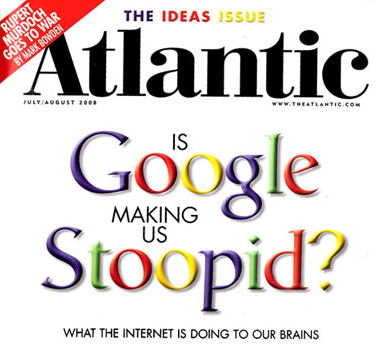Warning: This is a long article and not necessarily suitable to a glance. (See below on glances.)
I have been thinking a great deal about social media these days not only because of their importance, but also because of their ubiquity. There are some fundamental contradictions at work here that need more discussion. Let's take Twitter. Some people have thousands of followers. What exactly are they following? And more crucially, what does the word follow mean in this context?
Twitter is an endless flow of news and links between friends and strangers. It allows and sometimes encourages exchanges that have varying degrees of value. Twitter is also a tool for people who don't know each other to learn about shared interests. These are valuable aspects of this tightly wrought medium that tend towards the interactivity of human conversation.
On the other hand, Twitter like many Blogs is really a broadcast medium. Sure, followers can respond. And sometimes, comments on blog entries suggest that a "reading" has taken place. But, individual exchanges in both mediums tend to be short, anecdotal and piecemeal.
The general argument around the value of social media is that at least people can respond to the circulation of conversations and that larger and larger circles of people can form to generate varied and often complex interactions. But, responses of the nature and shortness that characterize Twitter are more like fragments — reactions that in their totality may say important things about what we are thinking, but within the immediate context of their publication are at best, broken sentences that are declarative without the consequences that often arise during interpersonal discussions. So, on Twitter we can make claims or state what we feel with few of the direct results that might occur if we had to face our ‘followers’ in person.
Blogs and web sites live and die because they can trace and often declare the number of ‘hits’ they receive. What exactly is a hit? Hit is actually an interesting word since its original meaning was to come upon something and to meet with…. In the 21st century, hits are about visits and the more visits you have the more likely you have an important web presence. Dig into Google Analytics and you will notice that they actually count the amount of time ‘hitters” spend on sites. The average across many sites is no more than a few seconds. Does this mean that a hit is really a glance? And what are the implications of glancing at this and that over the period of a day or a month? A glance is by definition short (like Twitter) and quickly forgotten. You don’t spend a long time glancing at someone.
Let’s look at the term Twitter a bit more closely. It is a noun that means “tremulous excitement.” But, its real origins are related to gossiping. And, gossiping is very much about voyeurism. There is also a pejorative sense to Twitter, chattering, chattering on and on about the same thing. So, we are atwitter with excitement about social media because they seem to extend our capacity to gossip about nearly everything which may explain why Justin Bieber has been at the top of discussions within the twitterverse. I am Canadian and so is he. Enough said.
Back to follow for a moment. To follow also means to pursue. I will for example twitter about this blog entry in an effort to increase the readership for this article. In a sense, I want you the reader, to pursue your interest in social media with enough energy to actually read this piece! To follow also means to align oneself, to be a follower. You may as a result wish to pursue me @ronburnett.
But the real intent of the word follow is to create a following. And the real intent of talking about hits is to increase the number of followers. All in all, this is about convincing people that you have something important and valuable to say which means that social media is also about advertising and marketing. This explains why businesses are justifiably interested in using social media and why governments are entering the blogosphere and the twitterverse in such great numbers.
Here is the irony. After a while, the sheer quantity of Twitters means that the circle of glances has to narrow. Trends become more important than the actual content. Quantity rules just like Google, where the greater the number of hits, the more likely you will have a site that advertisers want to use. Remember, advertisers assume that a glance will have the impact they need to make you notice that their products exist. It is worth noting that glancing is also derived from the word slippery.
As the circle of glances narrows, the interactions take on a fairly predictable tone with content that is for the most part, newsy and narcissistic. I am not trying to be negative here. Twitter me and find out.
Part Two
 Monday, July 12, 2010 at 5:23AM
Monday, July 12, 2010 at 5:23AM 


![Reblog this post [with Zemanta]](http://img.zemanta.com/reblog_e.png?x-id=64926e95-e8c3-4ebc-9260-09863c3a040d)

